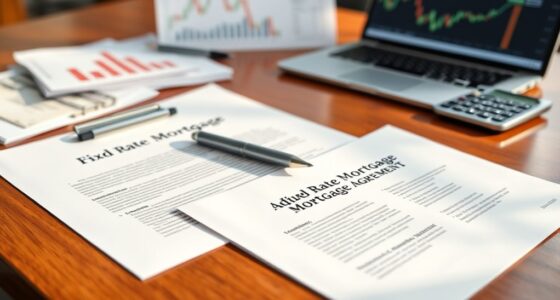Inflation happens when more money floods the economy, making prices rise because there’s too much cash chasing limited goods. Your expectations about future price increases can lead you to spend more now, which pushes prices higher even further. Businesses also raise prices if they think costs or wages will go up. Central banks try to slow inflation by changing policies, but if everyone expects prices to keep rising, inflation can stick around longer. Keep exploring to see how these factors influence prices over time.
Key Takeaways
- Inflation occurs when the money supply increases faster than the production of goods and services.
- Consumer and business expectations of rising prices lead to increased demand and preemptive price hikes.
- Higher demand fueled by expectations pushes prices upward, creating a self-reinforcing inflation cycle.
- Central banks attempt to control inflation by raising interest rates, but effectiveness depends on managing expectations.
- Persistent inflation is driven by the combined effect of increased money supply and collective expectations of rising prices.

Have you ever wondered why prices for everyday goods seem to rise over time? It’s a question many people ask as they notice their grocery bills, gas prices, or rent creeping upward year after year. The answer lies in the complex relationship between the money supply, consumer expectations, and how they influence inflation. When the government or central bank increases the money supply—meaning there’s more money circulating in the economy—it can lead to higher prices. More money chasing the same amount of goods creates a natural upward pressure on prices, which is a core driver of inflation.
But it’s not just about how much money is out there; what people expect also plays a *vital* role. If consumers believe that prices will rise in the future, they tend to buy more now rather than later. This increased demand can push prices higher, reinforcing inflation. For example, if everyone expects fuel prices to jump next month, you might fill your tank more frequently or buy in bulk, which can cause demand to spike temporarily. Businesses, noticing these expectations, might raise their prices preemptively, fueling a cycle of rising costs and prices. This phenomenon shows that consumer expectations can sometimes act as a self-fulfilling prophecy—if everyone believes prices will go up, they’re more likely to act in ways that make that happen.
When the central bank sees a growing money supply and rising consumer expectations about inflation, it might try to control the situation by tightening monetary policy—raising interest rates or reducing the amount of money in circulation. However, these measures take time to influence prices and often depend on how well consumers and businesses anticipate future conditions. If people start to expect inflation to persist, they might demand higher wages or increase their spending, which can keep prices rising even if the central bank is trying to cool down the economy. Additionally, color accuracy in the perception of price changes can influence how consumers respond to inflationary pressures.
In essence, inflation isn’t just about printing more money; it’s also about perceptions and expectations. When consumers and businesses believe prices will rise, their actions can accelerate the process, creating a cycle that sustains inflation. Understanding this dynamic helps explain why inflation can sometimes seem out of control, even when policymakers try to rein it in. So, next time you see prices climbing, remember that it’s a combination of how much money is in the system and what everyone expects will happen in the future—both of which have a *significant* influence on the cost of living.
Frequently Asked Questions
How Does Inflation Affect Different Income Groups?
Inflation impacts different income groups unevenly. You’ll notice lower-income households feel the pinch more because income disparity widens, making it harder to keep up with rising prices. Your savings erode faster as inflation reduces their value, especially if they’re not invested in assets that outpace inflation. Higher-income groups may better protect themselves, but everyone feels some strain, highlighting the importance of financial planning to mitigate inflation’s effects.
Can Inflation Be Controlled Without Harming Economic Growth?
Yes, you can control inflation without harming economic growth by carefully using monetary policy and fiscal measures. Central banks can raise interest rates to reduce demand, while governments can adjust spending and taxation to stabilize prices. When these tools are balanced effectively, they slow inflation without causing a recession. Your economy benefits from stable prices and sustained growth, ensuring that inflation stays in check without damaging overall economic health.
What Is the Difference Between Inflation and Hyperinflation?
Ever wonder how inflation differs from hyperinflation? Inflation is a moderate rise in prices, usually controlled by monetary policy and inflation targets set by central banks. Hyperinflation, however, spirals out of control, causing prices to skyrocket rapidly, destabilizing the economy. While inflation is manageable, hyperinflation can wipe out savings and erode trust in currency. Understanding this difference helps you grasp the importance of sound economic policies to maintain stability.
How Do Central Banks Decide on Interest Rate Changes?
You see, central banks decide on interest rate changes by analyzing economic indicators like inflation, employment, and growth. They use monetary policy to adjust the interest rate, either raising it to slow down inflation or lowering it to stimulate activity. When inflation rises, they often increase the interest rate to curb spending. Conversely, if the economy stalls, they lower the rate to encourage borrowing and investment.
What Are the Long-Term Effects of Persistent Inflation?
Imagine your savings slowly drowning in a flood of rising prices. Persistent inflation leads to wage stagnation, making it harder for you to keep up with costs. Over time, your purchasing power erodes, and your savings lose value, like a sandcastle succumbing to the tide. This cycle discourages long-term investments, hampers economic growth, and leaves you financially vulnerable, stuck in a frustrating race where the finish line keeps moving farther away.
Conclusion
Now that you understand how inflation makes prices soar like a rocket, you’re better equipped to spot its sneaky tricks. Remember, even tiny shifts in the economy can snowball into a tidal wave that affects your wallet more than you’d ever imagine. Keep an eye on those prices and stay informed—you don’t want inflation to catch you off guard like a lightning strike in a clear sky. Stay sharp and protect your money!









